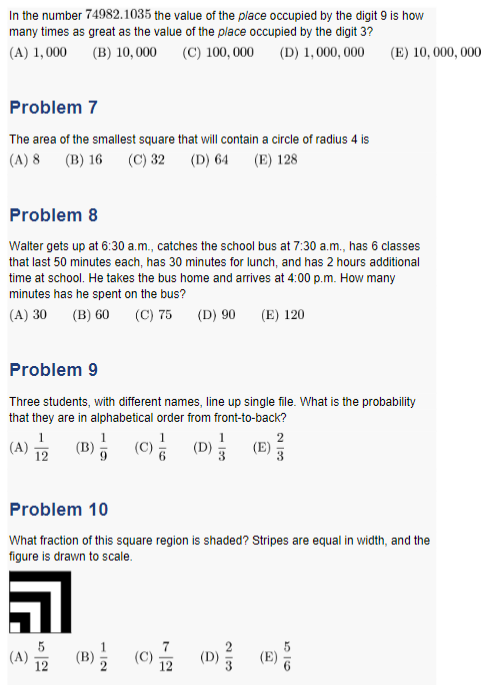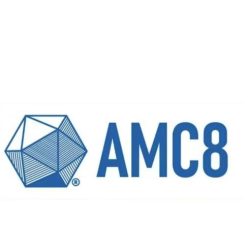1996年AJHSME真题
- 这是一个包含25个问题的单项选择题测试。每个问题后面都有标记为A、B、C、D和E的答案。其中只有一个是正确的。每个正确答案得1分。错误的答案不会扣分。
- 除普通纸、书写工具、尺子和橡皮外,不允许使用任何辅助工具。特别是,不允许使用方格纸、指南针、量角器、计算器、电脑、智能手表和智能手机。
- 您将有40分钟的工作时间来完成测试。
1996年AJHSME真题+答案在线试做!
以下是整理好的中英双语真题试卷,还有全英版真题供您选择!
1996年AJHSME 真题:
Problem 1
How many positive factors of 36 are also multiples of 4?
![]()
Problem 2
Jose, Thuy, and Kareem each start with the number 10. Jose subtracts 1 from the number 10, doubles his answer, and then adds 2. Thuy doubles the number 10, subtracts 1 from her answer, and then adds 2. Kareem subtracts 1 from the number 10, adds 2 to his number, and then doubles the result. Who gets the largest final answer?
![]()
Problem 3
The 64 whole numbers from 1 through 64 are written, one per square, on a checkerboard (an 8 by 8 array of 64 squares). The first 8 numbers are written in order across the first row, the next 8 across the second row, and so on. After all 64 numbers are written, the sum of the numbers in the four corners will be
![]()
Problem 4
![]()
![]()
Problem 5
The letters ![]() ,
, ![]() ,
, ![]() ,
, ![]() , and
, and ![]() represent numbers located on the number line as shown.
represent numbers located on the number line as shown.
![[asy] unitsize(36); draw((-4,0)--(4,0)); draw((-3.9,0.1)--(-4,0)--(-3.9,-0.1)); draw((3.9,0.1)--(4,0)--(3.9,-0.1)); for (int i = -3; i <= 3; ++i) { draw((i,-0.1)--(i,0)); } label("$-3$",(-3,-0.1),S); label("$-2$",(-2,-0.1),S); label("$-1$",(-1,-0.1),S); label("$0$",(0,-0.1),S); label("$1$",(1,-0.1),S); label("$2$",(2,-0.1),S); label("$3$",(3,-0.1),S); draw((-3.7,0.1)--(-3.6,0)--(-3.5,0.1)); draw((-3.6,0)--(-3.6,0.25)); label("$P$",(-3.6,0.25),N); draw((-1.3,0.1)--(-1.2,0)--(-1.1,0.1)); draw((-1.2,0)--(-1.2,0.25)); label("$Q$",(-1.2,0.25),N); draw((0.1,0.1)--(0.2,0)--(0.3,0.1)); draw((0.2,0)--(0.2,0.25)); label("$R$",(0.2,0.25),N); draw((0.8,0.1)--(0.9,0)--(1,0.1)); draw((0.9,0)--(0.9,0.25)); label("$S$",(0.9,0.25),N); draw((1.4,0.1)--(1.5,0)--(1.6,0.1)); draw((1.5,0)--(1.5,0.25)); label("$T$",(1.5,0.25),N); [/asy]](https://latex.artofproblemsolving.com/8/9/9/8992c6d2efe4e3e9810fb5e24eeb698bbb7a86eb.png)
Which of the following expressions represents a negative number?
![]()
Problem 6
What is the smallest result that can be obtained from the following process?
Choose three different numbers from the set ![]() .
.
Add two of these numbers.
Multiply their sum by the third number.
![]()
Problem 7
Brent has goldfish that quadruple (become four times as many) every month, and Gretel has goldfish that double every month. If Brent has 4 goldfish at the same time that Gretel has 128 goldfish, then in how many months from that time will they have the same number of goldfish?
![]()
以下是我们为您整理的全英版pdf真题,扫码即可免费领取完整版:


扫码即可免费下载以上完整版真题+答案解析,
还可以免费下载近20年AMC8真题+答案解析⇓
